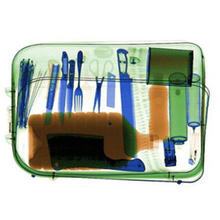MMSD Primary Focus Areas

Safety and Security
The division’s work in the Safety and Security provides the underpinning measurement science needed to advance threat detection, improve the accuracy of critical measurements and ensure the reliability of protective technologies and materials; the work falls generally into three categories: (1) improving national security, (2) enhancing public safety, and (3) advancing personal protection for law enforcement, border patrol, and first responders. There are many synergies and cross-cutting capabilities that the division leverages to maximize impact in these three categories, including multiscale, multi-domain hybrid metrology research, measurement standards and services, and trace analysis metrology research and development to enable the production and dissemination of standards, protocols, and test methods to meet persistent and evolving critical national needs identified through coordination with industry and government stakeholders.

Forensics and Public Health
Forensic science has been a prominent pillar of research at NIST since the release of 2009 National Academies of Sciences report Strengthening Forensic Science in the Unites States: A Path Forward. While the forensics research portfolio across NIST is broad, within MMSD the focus is specifically on forensic chemistry disciplines – seized drugs analysis, ignitable liquids analysis, gunshot residue analysis, and trace evidence. Within MMSD we have prioritized collaboratively addressing current forensic chemistry measurement challenges. To accomplish this, NIST scientists work directly with forensic practitioners at the local, state, federal, and international levels to identify pressing needs in the community and develop innovative, effective solutions that are practical and implementable. The products of this research are tangible methods, technologies, tools, data, and materials that enable forensic practitioners to analyze casework with increased safety, effectiveness, objectivity.

Micro and Nano Plastics
Our efforts are focused on the measurement science needed to improve detection, identification, and quantification of plastic particles. Current measurement methods for microplastics (MP) generally lack required sensitivity to detect nanoplastics (NP). Currently available microplastic and nanoplastic (MNP) materials are insufficient to develop the metrology and meet industrial needs. Thus, MMSD’s MNP Metrology Focus Area aims to support our diverse stakeholder groups by i) developing protocols for reproducible material production that facilitate measurement science advancement, and ii) develop needed metrology to examine MNP particle evolution in complex matrices using advanced microscopy, spectroscopy, and mass spectrometry techniques. NIST efforts are focused on the needed tools to improve risk assessment and support development of sustainable commercial products.
Semiconductors
While the recent passing of the CHIPS Act has generated significant interest in the materials science and metrology needs of the semiconductor industry, MMSD already has a long history of working with stakeholders in this industry to develop new measurement techniques and reference materials that meet these needs. In 2022, an effort was begun within MMSD to coordinate these efforts under a single program, with the intent of being a more efficient use of our limited resources and maximizing our impact for our stakeholders. These efforts are still ongoing, but in general projects in this space fall into one of three programmatic categories: (1) 3D chemical and structural imaging, (2) nanomechanical property measurement, or (3) thermal property measurement. Additionally, MMSD’s partnership with Brookhaven National Laboratory offers access to a unique suite of measurement capabilities that are well aligned with the needs of the semiconductor industry. Finally, MMSD possesses several unique capabilities and areas of expertise that are well aligned with the industrial needs identified by the CHIPS program, putting MMSD in a strong position to respond to any specific calls to action.

Industrial Gas Separation and Purification
Gas separation technology has widespread applications across a broad array of industrial sectors, including energy generation, chemical manufacturing, semiconductors, and aerospace. Examples include the removal of impurities from methane in natural gas processing and the separation of light hydrocarbons (ethane/ethylene) for petrochemical feedstocks. An emerging class of materials that has shown significant promise in these applications are metal-organic frameworks (MOFs) and covalent organic frameworks (COFs). These materials have important properties, including high surface area, pore size tunability, and chemical selectivity in adsorption that make them attractive for gas separation applications. The development of methodologies for material identification and selection, along with those for characterization of structure-property-performance relationships, is key to optimizing the development of these materials for specific applications. This methodology development is the central area of effort for MMSD researchers in the Gas Separation and Purification focus area.

Ceramic Additive Manufacturing
Development and commercialization of additive manufacturing (AM) have been a national priority since the 2012 White House We Cannot Wait initiative. The importance of AM to the resiliency of the national supply chain has been highlighted by the current administration in the AM Forward program. AM is a disruptive technology with potential applications in nearly all industrial sectors. The last decade has seen significant advances in metal and polymer AM, whereas the development of ceramic AM lags because of the unique challenges in material forming, shaping and post-processing. Despite these challenges, ceramic AM is actively explored for fabricating components in the aerospace, defense, energy, and health applications, and has already been employed in tooling for investment casting of engine parts. Our motivation and goals are to facilitate the industrialization of ceramic AM by addressing barriers to adopting these technologies. We are leveraging our expertise in measurements and simulations of material processes to develop rigorous metrology-based solutions for characterizing difficult-to-measure rheological properties of ceramic feedstock for direct-ink writing (DIW) and to implement in-situ/operando characterization of ceramics evolution during AM build and post-processing using synchrotron-based high-energy X-ray scattering and tomography. Concurrently, we are working with the ceramics AM community and ASTM/ISO committees to coordinate and organize standards activities in ceramic AM, including interlaboratory studies.

